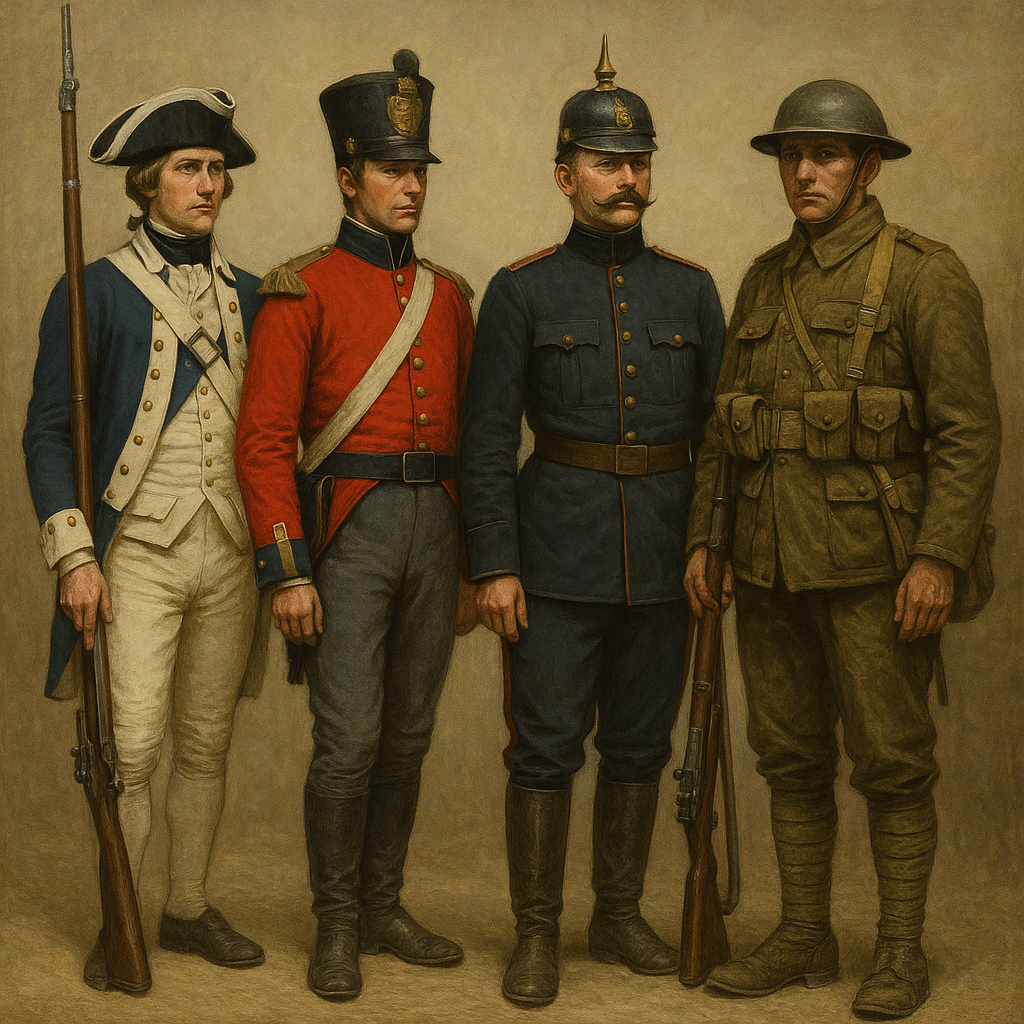
WWI Uniform History: Evolution of Old Military Outfits and Their Lasting Legacy
Published on Jun 14, 2025
WWI Uniform History: Evolution of Old Military Outfits and Their Lasting Legacy
War has always left an indelible mark on history—not just through battles and treaties but through the garments soldiers wore. Among the most significant chapters in military attire is the WWI uniform history, a turning point that transitioned the classic old military outfits of the 18th and 19th centuries into the more practical and utilitarian uniforms of the modern era.
Understanding WWI military dress requires a dive into its roots, including influences from previous wars, such as the blue coats of the American Revolution and 19th-century European armies. Let's walk through the evolution, symbolism, and significance of these uniforms.
Before WWI: A Legacy of Color and Ceremony
Prior to the First World War, military uniforms were as much about visual impact as they were about functionality. Bold colours, polished boots, brass buttons, and feathered hats made soldiers easily identifiable, which was both a source of pride and a tactical disadvantage.
Blue Coats and the American Revolution
One of the most iconic early military outfits is the blue coat worn during the American Revolution. These blue coats weren't just stylistic—they represented the break from British red and signified a new American identity. Though they date back to the 18th century, these uniforms are often referenced in studies of old army dress uniforms, helping us understand the transition toward national symbolism in uniform design.
Much like their European counterparts, early American uniforms leaned heavily on bright colour palettes, epaulettes, and highly decorative elements.
Old Military Outfits: The Aesthetic of Prestige
Moving into the 19th century, particularly the Napoleonic and Victorian eras, military uniforms remained elaborate. Soldiers wore tall shakos, colourful sashes, and tight-fitting tunics. These outfits were designed to evoke fear and respect but did little in terms of camouflage or comfort.
Examples include:
- British redcoats
- French blue infantry uniforms
- German pickelhaube helmets
These old military outfits were tailored for linear warfare—soldiers advancing in formation. But with the onset of modern warfare in the 20th century, everything changed.
The WWI Uniform Revolution
When World War I erupted in 1914, it ushered in a new kind of warfare—trench warfare. The flamboyant and ceremonial attire of old was no longer practical. Soldiers needed clothing that could withstand mud, cold, and extended wear. This necessity sparked a revolution in military uniform design.
From Form to Function
Gone were the bold reds and blues; in came the drab earth tones. Uniforms were redesigned with survival in mind:
- British Army: Introduced khaki uniforms made of wool serge fabric, paired with the Brodie helmet (a wide-brimmed steel helmet for protection).
- German Army: Wore the Feldgrau (field grey) uniform, which was both practical and tactically advantageous in muddy battlefields.
- French Army: Transitioned from blue coats and red trousers to the less conspicuous horizon blue uniforms.
This transformation reflected a broader shift—from uniforms as ceremonial attire to vital battlefield equipment.
Components of a WWI Uniform
While each nation had its variation, a typical WWI uniform included:
- Tunic and trousers: Usually wool, durable but heavy when wet
- Puttees: Cloth wrapped around the lower legs for ankle support
- Steel helmet: The introduction of helmets marked a major advancement in soldier protection
- Webbing and packs: For carrying ammunition, water, tools, and rations
These were all made with the goal of practicality, endurance, and camouflage—something unseen in old army dress uniforms of previous centuries.
Symbolism and Legacy
While functionality drove the design of WWI uniforms, they still carried strong symbolic weight. Rank insignias, regimental badges, and medals conveyed hierarchy and pride. Even in the trenches, uniforms maintained the spirit of tradition, albeit in a more subdued fashion.
Connection to Historical Military Uniforms
The evolution didn't erase the past. In fact, many WWI uniforms retained elements from earlier eras:
- Colours and insignia were often nods to regimental history
- Tailoring and buttons echoed styles from old European military traditions
- Ceremonial uniforms for parades or officer duties still retained classic design cues
At Paddelaters, we celebrate this connection through our curated collection of historical military uniforms, bridging the gap between the old military outfits of past centuries and the utilitarian brilliance of WWI gear.
WWI Uniforms vs. Blue Coats of the American Revolution
It's fascinating to compare the blue coats of the American Revolution with the field-grey or khaki tones of WWI. One was designed for symbolic rebellion and identification, the other for survival in muddy trenches and chemical warfare. Yet, both reflect their time's socio-political context, tactics, and technology.
Why WWI Uniforms Still Matter Today
Understanding the history of WWI uniforms gives us insight into more than just fabric and stitching. It tells the story of:
- Changing warfare tactics
- Shifts in industrial capabilities
- Societal values (e.g., nationalism, sacrifice, identity)
- Human adaptability under duress
Collectors, historians, reenactors, and educators all turn to resources like Paddelaters to keep this heritage alive.
Explore Our Collection of Historical Military Uniforms
At Paddelaters, we specialize in high-quality reproductions and authentic pieces from military history. Whether you're looking for a blue coat from the American Revolution, a complete WWI infantry set, or simply researching old army dress uniforms, our catalogue offers something for every enthusiast.
Visit our Historical Military Uniforms page to explore timeless pieces from past conflicts.
Conclusion
WWI uniforms weren't just the clothes soldiers wore—they were a manifestation of global change. From the vivid blue coats of the American Revolution to the muddy, battle-worn gear of WWI trenches, the evolution of military dress tells us how war reshaped identity, design, and necessity.
